Wild_Bill_Kelso
Senior Master Sergeant
- 3,231
- Mar 18, 2022
I'm not sure they will use the submarines "smarter".
USN could and did implement USW from practically 8/Dec/'41, but the last thing the UK wants is any current or future implementing that on them. (I recognize the KM was treading very thin line, but they weren't going all out at USW right out of the blocks)
Yeah I surmised as much
Same goes for RADAR and by extension homing beacons/radio communications/IFF: From posts here and on the navweaps site, it appears RN was so concerned with their enemy using SIGINT, that they didn't use the advantages that they had.
This is a very interesting point
While PoW did have legit issues with her RADAR operating in tropical conditions, it is looking more and more to me that it was also a conscientious decision to leave it turned off to prevent IJN forces from homing on it. If it isn't turned on, it isn't providing an advantage.
Very interesting. Always an issue with radar.
RN had Catalina fly over Bismarck to "relocate" her rather than provide Germany with inkling that their RDF was what gave Lütjens away. While if you're maintaining silence you're not giving your location away, you're also not providing your forces updates on your situation.
I didn't realize they tracked Bismarck via the radio direction finder
Without homing beacons allowing FAA aircraft to locate the carrier, a navigator is a critical to RN requirements.*
Up until the end of the Anglo-Japanese Alliance, IJN is partial to all the RN development in these area, so RN has legit concern.
So that is the reason why Fulmar and Firefly are required to have a second crewmember while nobody else's naval fighters do.
Without ETO/MTO experience, will FAA be operating Blackburn Rocs as its primary fighter? Will the follow on even be the Fulmar, but rather a next generation turret fighter - there were enough spec being floated for one. Does the Spitfire end after initial production as Hawker has Tornado/Typhoon as the RAF primary fighter.
Seems like the good characteristics of the Spitfire would be obvious even without combat, while the teething issues of the Tornado and Typhoon were well known. And certainly the first hint of combat anywhere around Europe, no matter how small, would reveal the merits of the Spitfire.
On other hand, Commonwealth forces fight such a different war that its hard to control all the butterflies.
Keep in mind, the Commonwealth did fight in the Pacific, not only the British but also in a big way, the Australians, and to a slightly lesser extent the New Zealanders. Even the Canadians even got involved a bit.




